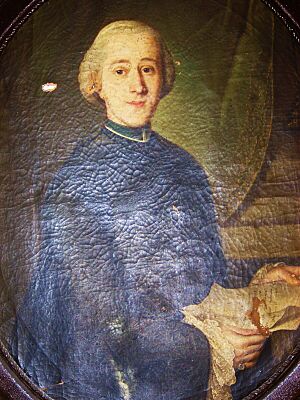Stjepan Gradić facts for kids
Quick facts for kids
Reverend
Stjepan Gradić
|
|
|---|---|
 |
|
| Born | March 6, 1613 |
| Died | 2 May 1683 (aged 70) |
| Resting place | San Girolamo degli Illirici |
| Nationality | Ragusan |
| Alma mater | Roman College Collegio Clementino University of Bologna |
| Occupation | Catholic priest, philosopher, philologist, scientist, diplomat, poet, librarian |
| Parent(s) | Michele Gradi and Maria Gradi (née Benessa) |
| Scientific career | |
| Institutions | Vatican Library |
| Influences | |
| Influenced | Roger Joseph Boscovich |
Stjepan Gradić, also known as Stefano Gradi, was a very smart person from the past. He was born on March 6, 1613, and passed away on May 2, 1683. People also knew him by his Latin name, Stephanus Gradius. He came from a place called the Republic of Ragusa, which is now part of Croatia.
Stjepan Gradić was a true polymath. This means he was an expert in many different subjects. He was a philosopher, a scientist, and a patrician. A patrician was a member of a high-ranking family in his home city.
Contents
Life Story of Stjepan Gradić
Stjepan Gradić was born in Dubrovnik, which was then known as Ragusa. His parents were Miho Gradi and Marija Benessa. He went to school in his hometown first.
Moving to Italy for Studies
Later, his uncle, Petar Benessa, who was an important church leader in Ragusa, sent him to Rome. In Rome and in Bologna, Stjepan studied many different subjects. He learned about philosophy, theology (the study of religion), law, and mathematics.
His math teachers were famous scientists of their time. In Rome, he studied with Bonaventura Cavalieri. In Bologna, his math professor was Benedetto Castelli.
Becoming a Priest and Diplomat
In 1643, Stjepan Gradić became a Catholic priest. He returned home to Ragusa that same year. Soon after, he became the abbot of a monastery on Pašman island. He also became a canon in the cathedral choir in Ragusa. This meant he was an important member of the church.
After a trip to Rome, he decided to stay there. He became the official representative of the Republic of Ragusa. He worked as a diplomat for his home country. His job was to represent Ragusa to the Holy See, which is the government of the Catholic Church. He stayed in Rome until he passed away.
In 1682, he became the head of the Vatican Library. This is one of the most important libraries in the world.
Working with Other Scholars
Stjepan Gradić was a very busy and talented person. He worked with a historian named Joannes Lucius. Together, they defended their home country from unfair criticism by writers from Italy and France.
He also translated books by ancient authors. He wrote a biography of a writer from Ragusa named Junije Palmotić. He even wrote a poem about a terrible earthquake that hit Dubrovnik in 1667.
Stjepan Gradić was part of important groups of thinkers. He discussed science and philosophy with Pope Alexander VII and Christina, Queen of Sweden.
Helping His Hometown
When the big earthquake hit Ragusa in 1667, it caused a lot of damage. Stjepan Gradić wrote about this disaster in Latin poems. More importantly, he helped organize aid from all over Europe to help his devastated city.
Stjepan Gradić's Scientific Work
Besides philosophy, Stjepan Gradić was very interested in mathematics, physics, astronomy, and literature. He was also a skilled diplomat.
Mathematics and Physics
In mathematics, he studied a problem known as Galileo's paradox. This paradox deals with the idea of infinite sets and how they can seem to have the same number of elements even if one is a subset of the other.
He wrote a mathematical paper called De loco Galilaei quo punctum lineae aequale pronuntiat. In this work, he talked about the idea of indivisible points. He also developed ideas that were similar to the "infinitesimal method." This method is used in advanced math to study very small changes.
He solved many math problems. Some of these problems were from another famous mathematician named Marin Getaldić. Stjepan Gradić also wrote about how things move naturally. He studied the laws of acceleration and how objects fall. He discussed these ideas with other scientists like Giovanni Alfonso Borelli and Honoré Fabri. He also wrote about the true and apparent position of the North Star.
See also
- List of notable Ragusans
- Dalmatia
- House of Gradić


